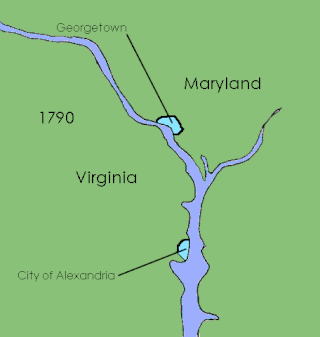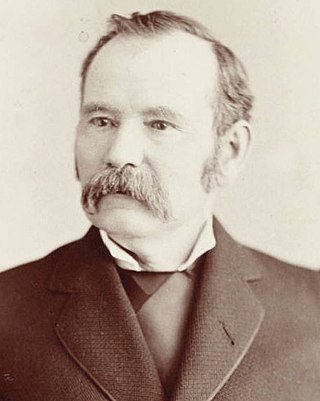The following table indicates the party of elected officials in the United States federal district Washington, D.C.
With the enactment of the 23rd amendment to the Constitution in 1961, [1] the district has been permitted to participate in presidential elections. It is part of the "blue wall", [2] having voted for all Democratic nominees since 1964.
The majority of residents want the district to become a state and gain full voting representation in Congress, which was confirmed with a 2016 referendum. [3] To prepare for this goal, the district has been electing shadow congresspeople since 1990. The shadow senators and shadow representative emulate the role of representing the district in Congress and push for statehood alongside the non-voting House delegate. [4] All shadow congresspeople elected have been Democrats.

The Twenty-third Amendment to the United States Constitution extends the right to participate in presidential elections to the District of Columbia. The amendment grants to the district electors in the Electoral College, as though it were a state, though the district can never have more electors than the least-populous state. How the electors are appointed is to be determined by Congress. The Twenty-third Amendment was proposed by the 86th Congress on June 16, 1960; it was ratified by the requisite number of states on March 29, 1961.
The posts of shadow United States senator and shadow United States representative are held by elected or appointed government officials from subnational polities of the United States that lack congressional vote. While these officials are not seated in either chamber of Congress, they seek recognition for their subnational polity, up to full statehood. This would enfranchise them with full voting rights on the floor of the US House and Senate, alongside existing states. As of 2021, only the District of Columbia and Puerto Rico currently have authorized shadow delegations to Congress.

The District of Columbia statehood movement is a political movement that advocates making the District of Columbia a U.S. state, to provide the residents of the District of Columbia with voting representation in the Congress and complete control over local affairs.

The Council of the District of Columbia is the legislative branch of the government of the District of Columbia. As permitted in the United States Constitution, the district is not part of any U.S. state and is overseen directly by the federal government.

District of Columbia home rule is the District of Columbia residents' ability to govern their local affairs. As the federal capital, the Constitution grants the United States Congress exclusive jurisdiction over the District in "all cases whatsoever".

Voting rights of citizens in the District of Columbia differ from the rights of citizens in the 50 U.S. states. The United States Constitution grants each state voting representation in both houses of the United States Congress. It defines the federal district as being outside of any state, and does not grant it any voting representation in Congress. The Constitution grants Congress exclusive jurisdiction over the District in "all cases whatsoever".

District of Columbia retrocession is the act of returning some or all of the land that had been ceded to the federal government of the United States for the purpose of creating its federal district for the new national capital, which was moved from Philadelphia to what was then called the City of Washington in 1800. The land was originally ceded to the federal government by Virginia and Maryland in 1790. After moving through various stages of federal and state approval, the Virginia portion was returned in March 1847.

The District of Columbia holds general elections every two years to fill various D.C. government offices, including mayor, attorney general, members of the D.C. Council, members of the D.C. State Board of Education, and members of its Advisory Neighborhood Commissions. Special elections may be held to fill vacancies at other points in time. Additionally, citywide ballot measures may be proposed and voted on.

The District of Columbia Organic Act of 1871 is an Act of Congress that repealed the individual charters of the cities of Washington and Georgetown and established a new territorial government for the whole District of Columbia. Though Congress repealed the territorial government in 1874, the legislation was the first to create a single municipal government for the federal district.

The District of Columbia has a mayor–council government that operates under Article One of the United States Constitution and the District of Columbia Home Rule Act. The Home Rule Act devolves certain powers of the United States Congress to the local government, which consists of a mayor and a 13-member council. However, Congress retains the right to review and overturn laws created by the council and intervene in local affairs.
The District of Columbia Organic Act of 1801, officially An Act Concerning the District of Columbia, is an organic act enacted by the United States Congress in accordance with Article 1, Section 8 of the United States Constitution. It formally placed the District of Columbia under the control of the United States Congress and organized the territory within the district into two counties: Washington County to the north and east of the Potomac River and Alexandria County to the west and south. The charters of the existing cities of Georgetown and Alexandria were left in place and no change was made to their status. The common law of both Maryland and Virginia remained in force within the district. A court was established in each of the new counties.

The mayor of the District of Columbia is the head of the executive branch of the government of the District of Columbia. The mayor has the duty to enforce district laws, and the power to either approve or veto bills passed by the D.C. Council. In addition, the mayor oversees all district services, public property, police and fire protection, most public agencies, and the district public school system. The mayor's office oversees an annual district budget of $8.8 billion. The mayor's executive office is located in the John A. Wilson Building in Downtown Washington, D.C. The mayor appoints several officers, including the deputy mayors for Education and Planning & Economic Development, the district administrator, the chancellor of the district's public schools, and the department heads of the district agencies.
There are differing points of view on whether Puerto Rico's current political status as a territory of the United States should change. Four major viewpoints emerge in principle: that Puerto Rico maintains its current status, becomes a US state, becomes fully independent, or becomes a freely associated state.

A referendum on statehood for the District of Columbia was held on November 8, 2016. It was the first referendum on statehood to be held in the district. The District of Columbia was created following the passage of the Residence Act on July 9, 1790, which approved the creation of a national capital, the City of Washington on the Potomac River.

The District of Columbia was created in 1801 as the federal district of the United States, with territory previously held by the states of Maryland and Virginia ceded to the federal government of the United States for the purpose of creating its federal district, which would encompass the new national capital of the United States, the City of Washington. The district came into existence, with its own judges and marshals, through the District of Columbia Organic Act of 1801; previously it was the Territory of Columbia. According to specific language in the U.S. Constitution, it was 100 square miles (259 km2).

The 1876 Colorado gubernatorial election took place on October 3, 1876, to elect the 1st Governor of Colorado after the state was admitted to the union on August 1, 1876. Republican John Long Routt, last governor of the Colorado Territory, was elected in a close race against Democratic nominee Bela M. Hughes.

The Washington, D.C., Admission Act, often referred to simply as the D.C. Admission Act, is a bill introduced during the 116th United States Congress. The bill would grant Washington, D.C., admission into the Union as a state. The bill was originally introduced in the 116th Congress on January 3, 2019, and was reintroduced on January 4, 2021, and January 9, 2023, in the 117th and 118th Congresses. The United States House of Representatives passed it on April 22, 2021.
The District of Columbia is a political division coterminous with Washington, D.C., the capital city of the United States. According to the Article One of the Constitution, only states may be represented in the United States Congress. The District of Columbia is not a U.S. state and therefore has no voting representation.
The District of Columbia is a political division coterminous with Washington, D.C., the capital city of the United States. According to the Article One of the Constitution, only states may be represented in the United States Congress. The District of Columbia is not a U.S. state and therefore has no voting representation in the United States Senate. However, it does have a non-voting delegate to represent it in the House.